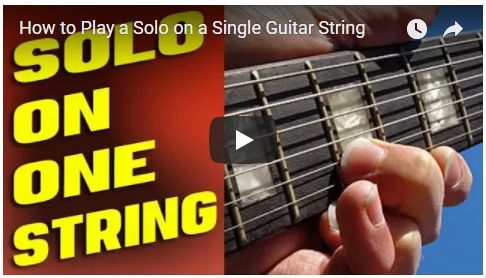How to Play a Solo on a Single Guitar String
Have you ever wondered about how playing a solo on only a single string might work? How does the scale get laid out. How do you view the scales root note? What's the process for playing lead like this? Well, in this lesson I want to help you understand how a guitar solo would function if it were performed on just one string...
In this lesson, we'll break down how to understand the key of your solo (when played across one string). We'll discuss how to pin-point the tonic of the scale, (so the root of the key is clear to you). Plus, we'll study how to think more horizontally when you're composing or improvising your lead guitar parts...
WATCH THE VIDEO:
Step #1). The first step when getting together your ideas for performing a one-string guitar solo will begin with determining your key signature. This means you'll need to be able to analyze the chord changes and determine the Tonic note, (along with the major or minor tonality) of the chord progression you'll build the solo over. In many cases this turns out to be the first chord you'll hear. Such as in this chord progression...
Sometimes the chord progressions will operate in reverse. In those cases, the key centers Tonic chord will show up at the end of the chord progression. I've composed an example like this using the same key as our last progression. In this jam the chords to flow into the root chord of the key, rather than away from it. See the example below...
Step #2). Once you've analyzed and established what the key signature of your progression is, and you know the tonality of the progression, (i.e., whether the progression is Major or Minor), the next step is that of determining "where" on the neck the tonic note is going to sit for your key and how the scale will be laid out along the string.
For example, if your progression was in the key of "D Minor," you'll want to understand where the root of "D" is sitting along the string, and how the scale would be laid out. For our example, we'll use the third guitar string, and build the "D Minor" scale along it.
Within the key of "D Minor" the "Tonic Note" of "D" is located on the 3rd-string, seventh fret. You'll be best off practicing how the layout of notes for the key can be developed through a practice routine for the "along one string" scale pattern. Make a study of the practice routine I've suggested below...
The goal is to memorize the scale along the entire string, so that in the long run you can compose or improvise melodies using single-string scale.
Step #3). This is the fun part. Now that you've sorted out your progression, and you've established the proper key, along with learning the scale layout along one string, you can start making up melodies.
When it comes to the creation of melody lines, you'll want to start the fun by recording the jam. I've already got the progression I'm going to use recorded into my looper pedal. The chord progression is in "D Minor" and sounds like this...
I've also composed a melody for you to try learning, (just something to help get you started with practicing this along one string soloing concept)... make a study of my example melody...
As you practice learning your scales, you'll find that almost every book and diagram method will focus on laying out the scale in vertical fret-board positions. And, that's good, there's nothing wrong with that.
That's how I learned my scales, and that's how I show all of my own students their scales on guitar. However, I do need to stress the value behind spending time performing scales along one guitar string. And, the value in forcing yourself out of the common in position box shapes, to develop guitar solos and melodies played along the neck. Plus, it's phenomenal for learning the scales notes, the key signatures and new ways of phrasing melodic ideas.
It helps your hands learn the neck better, and it helps your ear comprehend the sound of the scales structure so you can play all kinds of unique phrases that you're hearing in your head...
Thanks for joining me, If you'd like to, "Find Out What You Should Learn Next on Guitar" - take a look at the courses over on my website at CreativeGuitarStudio.com.
My step-by-step; Beginner, Intermediate and Advanced courses will cover what you need to know, along with how to be able to move forward and become the best player that you can be.
I've worked on these courses since 1992 and I feel that all together they're the best guitar program you'll ever find. The courses will help you learn to identify what's required to get you up to the next level of guitar playing, in a very organized way, that makes sense.
I look forward to helping you further at CreativeGuitarStudio.com ...Until next time - take care and we'll catch up again on the next lesson. Bye for now!
In this lesson, we'll break down how to understand the key of your solo (when played across one string). We'll discuss how to pin-point the tonic of the scale, (so the root of the key is clear to you). Plus, we'll study how to think more horizontally when you're composing or improvising your lead guitar parts...
WATCH THE VIDEO:
Step #1). The first step when getting together your ideas for performing a one-string guitar solo will begin with determining your key signature. This means you'll need to be able to analyze the chord changes and determine the Tonic note, (along with the major or minor tonality) of the chord progression you'll build the solo over. In many cases this turns out to be the first chord you'll hear. Such as in this chord progression...
Sometimes the chord progressions will operate in reverse. In those cases, the key centers Tonic chord will show up at the end of the chord progression. I've composed an example like this using the same key as our last progression. In this jam the chords to flow into the root chord of the key, rather than away from it. See the example below...
Step #2). Once you've analyzed and established what the key signature of your progression is, and you know the tonality of the progression, (i.e., whether the progression is Major or Minor), the next step is that of determining "where" on the neck the tonic note is going to sit for your key and how the scale will be laid out along the string.
For example, if your progression was in the key of "D Minor," you'll want to understand where the root of "D" is sitting along the string, and how the scale would be laid out. For our example, we'll use the third guitar string, and build the "D Minor" scale along it.
Within the key of "D Minor" the "Tonic Note" of "D" is located on the 3rd-string, seventh fret. You'll be best off practicing how the layout of notes for the key can be developed through a practice routine for the "along one string" scale pattern. Make a study of the practice routine I've suggested below...
The goal is to memorize the scale along the entire string, so that in the long run you can compose or improvise melodies using single-string scale.
Step #3). This is the fun part. Now that you've sorted out your progression, and you've established the proper key, along with learning the scale layout along one string, you can start making up melodies.
When it comes to the creation of melody lines, you'll want to start the fun by recording the jam. I've already got the progression I'm going to use recorded into my looper pedal. The chord progression is in "D Minor" and sounds like this...
I've also composed a melody for you to try learning, (just something to help get you started with practicing this along one string soloing concept)... make a study of my example melody...
As you practice learning your scales, you'll find that almost every book and diagram method will focus on laying out the scale in vertical fret-board positions. And, that's good, there's nothing wrong with that.
That's how I learned my scales, and that's how I show all of my own students their scales on guitar. However, I do need to stress the value behind spending time performing scales along one guitar string. And, the value in forcing yourself out of the common in position box shapes, to develop guitar solos and melodies played along the neck. Plus, it's phenomenal for learning the scales notes, the key signatures and new ways of phrasing melodic ideas.
It helps your hands learn the neck better, and it helps your ear comprehend the sound of the scales structure so you can play all kinds of unique phrases that you're hearing in your head...
_______________________ ♫ _______________________
Thanks for joining me, If you'd like to, "Find Out What You Should Learn Next on Guitar" - take a look at the courses over on my website at CreativeGuitarStudio.com.
My step-by-step; Beginner, Intermediate and Advanced courses will cover what you need to know, along with how to be able to move forward and become the best player that you can be.
I've worked on these courses since 1992 and I feel that all together they're the best guitar program you'll ever find. The courses will help you learn to identify what's required to get you up to the next level of guitar playing, in a very organized way, that makes sense.
I look forward to helping you further at CreativeGuitarStudio.com ...Until next time - take care and we'll catch up again on the next lesson. Bye for now!
___________________________________________________
GET GOOD NOW - JOIN THE MEMBERS AREA














